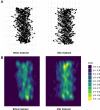Gait in Benign Paroxysmal Positional Vertigo
- PMID: 33643208
- PMCID: PMC7907458
- DOI: 10.3389/fneur.2021.633393
Gait in Benign Paroxysmal Positional Vertigo
Abstract
Purpose: Patients with benign paroxysmal positional vertigo (BPPV) experience gait unsteadiness not only during the attacks but also between the spells. This study aimed to measure gait changes in BPPV and determine whether these changes are associated with the involved canal or lesion side. Methods: We recruited 33 patients with a diagnosis of unilateral BPPV. Patients with other vestibular or central nervous system disorders were excluded. Gait was assessed using the GAITRite™ system before and after canalith repositioning treatment (CRT). Results: After CRT, improvements were observed in various gait parameters including velocity (p < 0.001), cadence (p < 0.001), functional ambulation profile (p = 0.011), and the coefficient of variation of stride time (p = 0.004). Exploration of the center of pressure (COP) distribution also revealed improved stabilization during locomotion after CRT. The spatiotemporal gait variables did not differ between the patients with horizontal- and posterior-canal BPPV, or between the ipsilesional and contralesional sides before CRT. Conclusions: The gait parameters reflecting velocity and rhythmicity along with stability of COP distribution improved after the resolution of BPPV. Episodic overexcitation of semicircular canal may impair the vestibular information that is integrated with the other reference afferent systems and lead to impaired gait performance.
Keywords: BPPV; gait; posture; vertigo; vestibular.
Copyright © 2021 Lim, Kang, Lee, Kim and Kim.
Conflict of interest statement
The authors declare that the research was conducted in the absence of any commercial or financial relationships that could be construed as a potential conflict of interest.
Figures

References
LinkOut - more resources
Full Text Sources
Other Literature Sources
Research Materials

